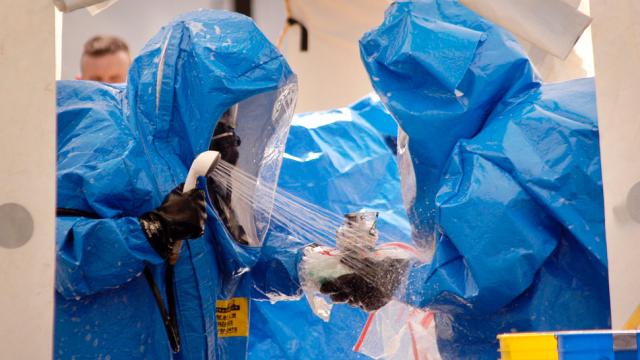There really is no remedy against a biological weapon attack, but Johns Hopkins University researchers hope the four-year, $US5.7 ($8) million grant DARPA recently awarded them will change that. The aim is for the researchers to create a bio-control system able to deploy single-cell fighters that will hunt down specific pathogens and destroy their lethality.
Researchers will start with two forms of bacteria. Legionella, a kind of bacteria that causes Legionnaire’s disease and Pseudomonas aeruginosa, which is the second-leading cause of infections in hospitals, according to Johns Hopkins University. If the tests conducted during the grant period prove successful, it is envisioned that these disease-fighting cells could be used to clean contaminated soil and defend against a bio-weapon attack.
What makes this bio-control system unique is that each engineered cell must seek and destroy dangerous bacteria without the help of a human controlling them:
“Once you set up this bio-control system inside a cell, it has to do its job autonomously, sort of like a self-driving car,” said Pablo A. Iglesias, principal investigator on the project. Iglesias, a professor of electrical and computer engineering in the Whiting School, shifted his research focus from man-made to biological control systems about 15 years ago.
“Think about how the cruise control in your car senses your speed and accelerates or slows down to stay at the pace you’ve requested,” Iglesias said. “In a similar way, the bio-control systems we’re developing must be able to sense where the pathogens are, move their cells toward the bacterial targets, and then engulf them to prevent infections among people who might otherwise be exposed to the harmful microbes.”
But there are a lot of challenges to fighting off a bio-terror attack besides creating a cell that would kill lethal pathogens, which, of course, would be a major breakthrough. And there are so many ways in which a bio-terror weapon can be sneaked into a sensitive location, even past the careful eyes of trained US federal agents.
Back in 2011, the New York Times asked whether America was ready to defend against a bio-terror attack. Not only was the answer clearly no, it was learned that not even White House security was able to detect a biological weapon that was brought directly to the US vice president’s feet.
A few days after 9/11, a retired US Air Force colonel named Randall Larsen went to the White House to speak with then-Vice President Dick Chaney about bio-terror defence. The guards checked him thoroughly, or so they thought. Larsen made his way to a security meeting where Chaney and other defence experts were present. Tara O’Toole, who also also served under the Obama administration as the top official for bio-defense research at the Department of Homeland Security, was leading a briefing on the findings of a study conducted three months earlier to determine how prepared the US was to fight a bio-terror attack:
As O’Toole began the presentation, Larsen studied Cheney’s expression. The vice president showed no reaction as O’Toole listed the officials who participated in the simulation, the complications they encountered as they tried to develop an emergency response and the arguments that broke out as they watched the disease spread beyond control. She concluded by telling the vice president that the country was unprepared for a biological attack.
Cheney nodded. “O.K.,” he said. “But what are we looking for? What does a biological weapon look like?”
At this, Larsen reached into his briefcase and pulled out a small test tube. “Mr. Vice President,” he said, “it looks like this.” Inside the tube was a weaponised powder of Bacillus globigii, almost genetically identical to anthrax. “And by the way,” Larsen said, “I just smuggled this into your office.”
At one of the most secure buildings in the world, in a moment of unprecedented alarm, the White House guards had searched Larsen’s briefcase — and never even saw the powder. “They were looking for the wrong things,” Larsen says now. “They still are.”
Indeed, getting the science down is one thing, but identifying how a biological weapon will be deployed is a completely different issue. But that doesn’t minimise the important work DARPA is funding.
In 2017, America is still pretty vulnerable to a bio-terror attack and there are few ways to fight lethal biological chemicals that could enter our water streams or hospitals without causing massive casualties. Currently, the Johns Hopkins researchers are not testing the bio-control system on human blood, and instead focusing on bacteria outside of the body.
If the study is successful, the cell fighters could be deployed into US hospital ventilation and cooling systems to fight bacteria causing infections. And if they are successful in that mission, America’s defence may finally have a counter against bio-terror attack.
